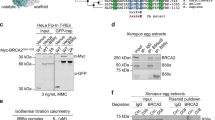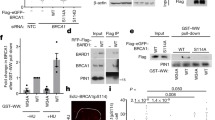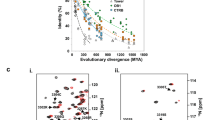Abstract
Individuals with BRCA2 mutations are predisposed to breast cancers owing to genome instability. To determine the functions of BRCA2, the human protein was purified. It was found to bind selectively to single-stranded DNA (ssDNA), and to ssDNA in tailed duplexes and replication fork structures. Monomeric and dimeric forms of BRCA2 were observed by EM. BRCA2 directed the binding of RAD51 recombinase to ssDNA, reduced the binding of RAD51 to duplex DNA and stimulated RAD51-mediated DNA strand exchange. These observations provide a molecular basis for the role of BRCA2 in the maintenance of genome stability.
This is a preview of subscription content, access via your institution
Access options
Subscribe to this journal
Receive 12 print issues and online access
$189.00 per year
only $15.75 per issue
Buy this article
- Purchase on Springer Link
- Instant access to full article PDF
Prices may be subject to local taxes which are calculated during checkout



Similar content being viewed by others
References
Moynahan, M.E. & Jasin, M. Nat. Rev. Mol. Cell Biol. 11, 196–207 (2010).
Bork, P., Blomberg, N. & Nilges, M. Nat. Genet. 13, 22–23 (1996).
Thorslund, T., Esashi, F. & West, S.C. EMBO J. 26, 2915–2922 (2007).
Yang, H. et al. Science 297, 1837–1848 (2002).
Esashi, F. et al. Nature 434, 598–604 (2005).
Ayoub, N. et al. Curr. Biol. 19, 1075–1085 (2009).
Yang, H., Li, Q., Holloman, W.K. & Pavletich, N.P. Nature 433, 653–657 (2005).
Petalcorin, M.I.R., Sandall, J., Wigley, D.B. & Boulton, S.J. J. Mol. Biol. 361, 231–242 (2006).
Shivji, M.K.K. et al. Nucleic Acids Res. 34, 4000–4011 (2006).
Shivji, M.K.K. et al. Proc. Natl. Acad. Sci. USA 106, 13254–13259 (2009).
Carreira, A. et al. Cell 136, 1032–1043 (2009).
Tal, A., Arbel-Goren, R. & Stavans, J. J. Mol. Biol. 393, 1007–1012 (2009).
Lekomtsev, S., Guizetti, J., Pozniakovsky, A., Gerlich, D.W. & Petronczki, M. J. Cell Sci. 123, 1395–1400 (2010).
Sy, S.M.H., Huen, M.S.Y. & Chen, J.J. Proc. Natl. Acad. Sci. USA 106, 7155–7160 (2009).
Benson, F.E., Stasiak, A. & West, S.C. EMBO J. 13, 5764–5771 (1994).
Zhou, Q. et al. Mol. Cell. Biol. 27, 2512–2526 (2007).
Shin, D.S. et al. EMBO J. 22, 4566–4576 (2003).
Gasior, S.L. et al. Proc. Natl. Acad. Sci. USA 98, 8411–8418 (2001).
Song, B.W. & Sung, P. J. Biol. Chem. 275, 15895–15904 (2000).
Sugiyama, T. & Kowalczykowski, S.C. J. Biol. Chem. 277, 31663–31672 (2002).
de Vries, F.A.T. et al. DNA Repair (Amst.) 4, 1121–1128 (2005).
Rijkers, T. et al. Mol. Cell. Biol. 18, 6423–6429 (1998).
Acknowledgements
We thank T. Hyman (Max Planck Institute, Dresden) for providing the BAC modification cassettes. This work was supported by grants to S.C.W. (Cancer Research UK, the Breast Cancer Campaign, the Louis-Jeantet Foundation, Swiss Bridge and the European Research Council) and to J.D.G. and S.A.C. (US National Institutes of Health). T.T. was supported by the Alfred Benzon Foundation and the Carlsberg Foundation and S.L. by a European Molecular Biology Organization fellowship.
Author information
Authors and Affiliations
Contributions
T.T. and S.C.W. designed the study; S.L. and M.P. made the BRCA2 constructs; T.T. and M.J.M. made the RAD51 expression vectors, purified the proteins and carried out the biochemical analyses; and S.A.C. and J.D.G. visualized BRCA2 by electron microscopy. S.C.W. wrote the manuscript with contributions from T.T., S.A.C. and J.D.G.
Corresponding author
Ethics declarations
Competing interests
The authors declare no competing financial interests.
Supplementary information
Supplementary Text and Figures
Supplementary Figures 1–6 and Supplementary Methods (PDF 9002 kb)
Rights and permissions
About this article
Cite this article
Thorslund, T., McIlwraith, M., Compton, S. et al. The breast cancer tumor suppressor BRCA2 promotes the specific targeting of RAD51 to single-stranded DNA. Nat Struct Mol Biol 17, 1263–1265 (2010). https://doi.org/10.1038/nsmb.1905
Received:
Accepted:
Published:
Issue Date:
DOI: https://doi.org/10.1038/nsmb.1905
This article is cited by
-
Bre1/RNF20 promotes Rad51-mediated strand exchange and antagonizes the Srs2/FBH1 helicases
Nature Communications (2023)
-
Repair of DNA double-strand breaks in plant meiosis: role of eukaryotic RecA recombinases and their modulators
Plant Reproduction (2023)
-
Rad52 mediates class-switch DNA recombination to IgD
Nature Communications (2022)
-
Dynamic interaction of BRCA2 with telomeric G-quadruplexes underlies telomere replication homeostasis
Nature Communications (2022)
-
A complex of BRCA2 and PP2A-B56 is required for DNA repair by homologous recombination
Nature Communications (2021)



